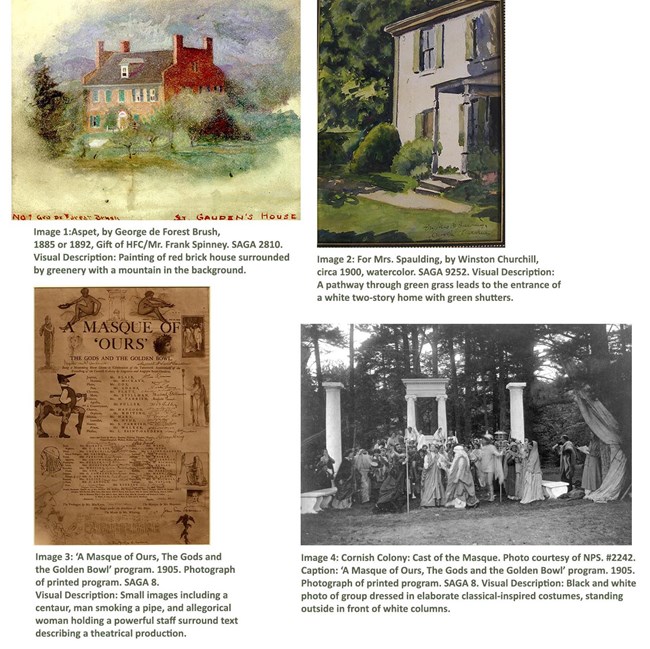A Circle of Friends Art Colonies of Cornish and Dublin

Augustus Saint-Gaudens was a fundamental figure of the Cornish Colony – a flourishing community of artists, writers, and other creatives that congregated around Cornish, New Hampshire at the turn of the century. Throughout the late 19th and early 20th century, the colony grew to encompass a diversity of painters, sculptors, poets, playwrights, actors, essayists, landscape designers and other patrons of the arts. This imaginative group of visionaries drew their inspiration from the scenic mural and cultivated a customs of conversation, critique, and socialization relating to their piece of work.
Some notable members include Louis St. Gaudens (Augustus' brother and boyfriend sculptor), Annetta Johnson Saint-Gaudens (Louis' married woman and fellow sculptor), Stephen Parrish and his son Maxfield (etcher/painter and painter/illustrator, respectfully), Kenyon Cox (painter), Percy Mackaye (poet), and Charles Platt (etcher and architect). A majority of these members initially resided in the expanse during the summer, opting to render to urban areas such every bit New York Urban center during the winter.
Augustus Saint-Gaudens founded the Colony when he moved to Cornish for the summer of 1885. Saint-Gaudens kickoff rented a firm from his friend Charles Beaman, a prominent New York lawyer who owned property in the area. With its sweeping view of Mt. Ascutney, Saint-Gaudens constitute the property to be a compelling environment to work on his "Standing Lincoln" sculpture for the summer. The sculptor brought his family and assistants with him and soon afterward, other creatives started to flock to the area. Between the fall of 1885 and bound of 1886, a painter named Thomas Dewing migrated to the area and barbarous in dearest with it. Although Saint-Gaudens is credited with starting the Colony, the sculptor himself says that Dewing'south words of praise attracted many more people to Cornish. Saint-Gaudens continued to hire the house from Beaman until 1891, when he finally purchased the belongings. They would go along to summer in that location until the Saint-Gaudens family moved to Cornish full-time in 1900.
Many artists took direct inspiration from the landscape and architecture around them. When George de Wood Brush (1855-1941) arrived in Cornish, he stayed on the Saint-Gaudens property with his wife. He painted the Saint-Gaudens house nestled into the lush, green mural, with Mt. Ascutney regally portrayed in the background. Winston Churchill (1871-1947) was another painter and prominent novelist of the Cornish Colony. His painting, 'For Mrs. Spaulding,' depicts the contrasting greenery and architecture of a firm upward the road in Plainfield, New Hampshire. For many of the members of the colony, the rural mural of Cornish supplied a creative interlude from their total-time urban lifestyles and is apparent in their piece of work from the fourth dimension.
A pivotal event for the colony happened in 1905, when the artists decided to put on a big-calibration play in honor of the Saint-Gaudens' twentieth ceremony of their arrival in Cornish. Entitled "A Masque of 'Ours,' The Gods and The Aureate Bowl," the outdoor performance was inspired past plays of the belatedly Renaissance. Written by the dramatist Louis Shipman (1869-1933), with an introduction by poet Percy Mackaye (1875-1956) and assistance from thespian John Blair (1875-1948) and musician-composer Arthur Whiting (1861-1936), the functioning was put on in a grove on the Aspet property. Sixty-five members of the Colony participated, dressing as diverse Greek gods and goddesses. Saint-Gaudens himself was wheeled in on a chariot. This masque represented a wedlock of many talents from the Cornish Colony and represents the strong friendships that blossomed in the Cornish countryside. Many relics from this Masque nevertheless reside in the drove, including this playbill that displays the signatures of many of the participants.
The Cornish Colony connected in the area until Augustus Saint-Gaudens' death in 1907. After this, the remaining artists slowly started to drift away. Saint-Gaudens National Historic Park preserves the legacy of the Cornish Colony, commemorating the art and community that was congenital here.
Works Cited:
Colby, Virginia Reed, and James B. Atkinson. Footprints of the By: Images of Cornish, New Hampshire & the Cornish Colony. Cornish, N.H.: Cornish Historical Society, 2010.
Saint-Gaudens, Augustus, and Homer Saint-Gaudens. The Reminiscences of Augustus Saint-Gaudens. New York: The Century Co., 1913.
U.S. Section of the Interior, National Park Service, Role of Archaeology and Historic Preservation, Division of History. "Augustus Saint Gaudens – The Man and His Fine art." John W. Bail. FNP-HH-71-30. Washington, D.C., 1967.
University of New Hampshire, and Thorne-Sagendorph Fine art Gallery. "A Circle of Friends: Art Colonies of Cornish and Dublin." Durham: Academy Fine art Galleries, Academy of New Hampshire, 1985.
Images 1: Aspet, past George de Forest Brush, 1885 or 1892, Gift of HFC/Mr. Frank Spinney. SAGA 2810.Visual Clarification: Painting of red brick house surrounded by greenery with a mountain in the groundwork.
Epitome 2: For Mrs. Spaulding, past Winston Churchill, circa 1900, watercolor. SAGA 9252.Visual Clarification: A pathway through dark-green grass leads to the entrance of a white two-story home with dark-green shutters.
Image 3:'A Masque of Ours, The Gods and the Aureate Bowl' program. 1905. Photograph of printed program. SAGA 8.Visual Clarification: Pocket-sized images including a centaur, man smoking a pipe, and allegorical woman holding a powerful staff surround text describing a theatrical product.
Paradigm four: Cornish Colony: Bandage of the Masque. Photo courtesy of NPS. #2242. 'A Masque of Ours, The Gods and the Gold Bowl' plan. 1905. Photograph of printed plan. SAGA 8.Visual Description: Black and white photo of group dressed in elaborate classical-inspired costumes, standing outside in front end of white columns.
Source: https://www.nps.gov/articles/000/the-cornish-colony.htm
0 Response to "A Circle of Friends Art Colonies of Cornish and Dublin"
Post a Comment